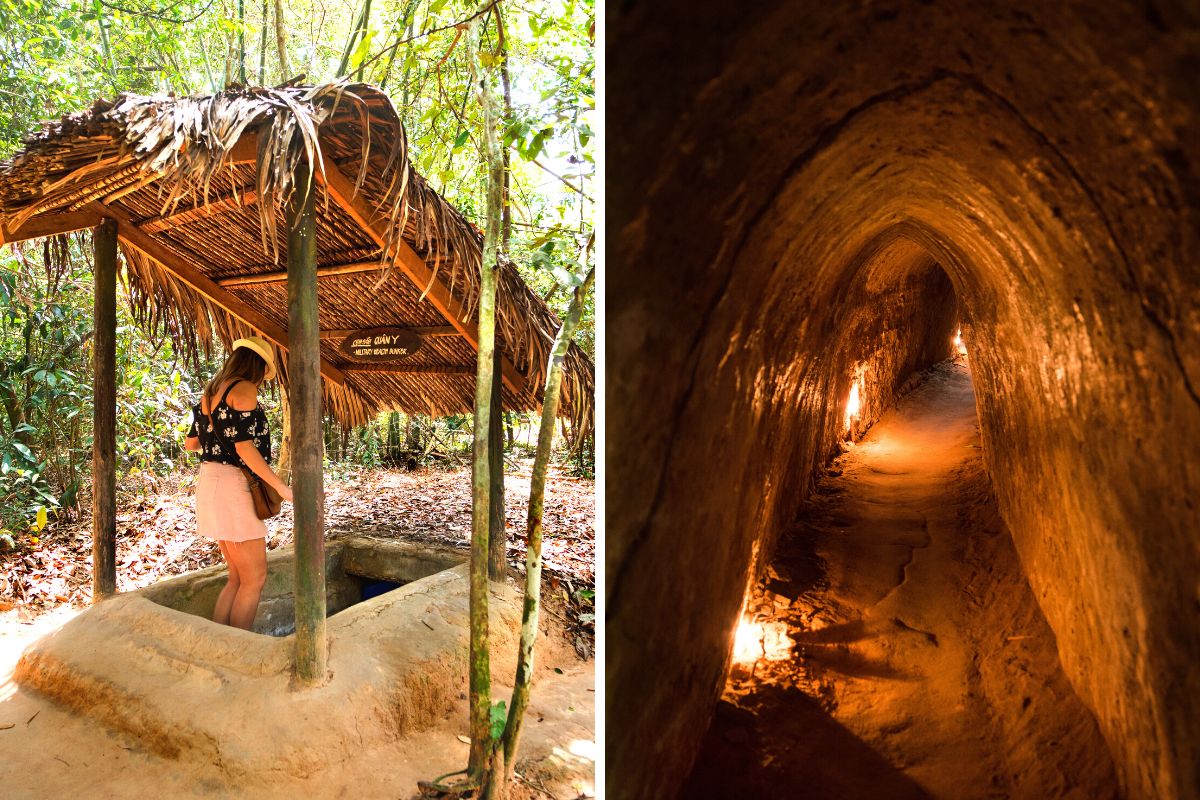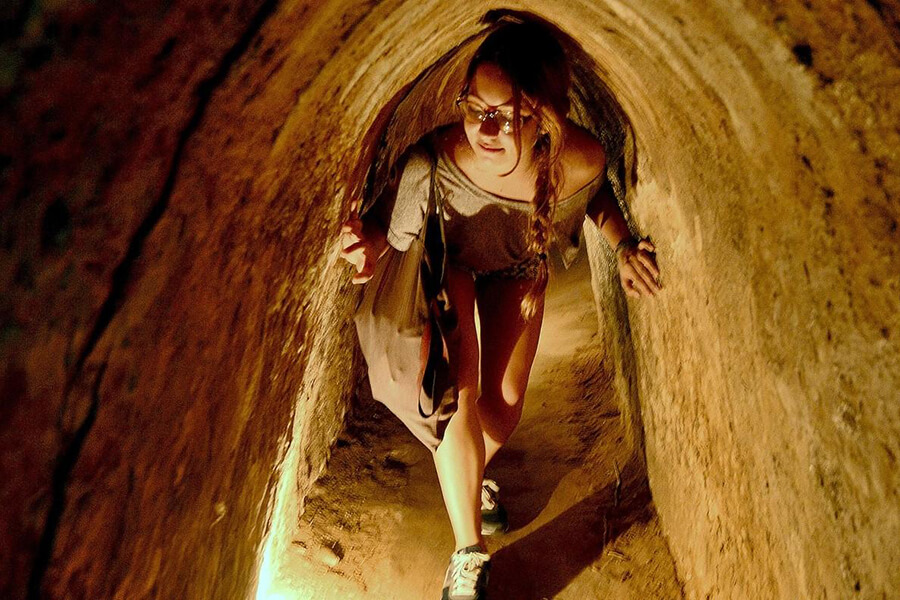Table of Contents
Nestled amidst the lush greenery of southern Vietnam, the Cu Chi Tunnels Ho Chi Minh city Vietnam stand as a testament to the resilience, ingenuity, and unwavering spirit of the Vietnamese people during the Vietnam War. As an intricate network of underground tunnels, bunkers, and living quarters, this subterranean marvel played a pivotal role in the war, serving as a vital base for guerrilla warfare and a symbol of resistance against foreign occupation. Join us as we delve into the fascinating history, construction, life within, and enduring legacy of the Cu Chi Tunnels.
History of Cu Chi Tunnels

The origins of the Cu Chi Tunnels Ho Chi Minh city Vietnam can be traced back to the early 1940s when the Vietnamese people, under the leadership of Ho Chi Minh, began their struggle for independence from French colonial rule. As the conflict intensified, the Viet Minh, a nationalist movement led by Ho Chi Minh, recognized the strategic significance of Cu Chi, a rural district located just northwest of Saigon (present-day Ho Chi Minh City). Its dense jungle terrain and proximity to the capital made it an ideal location for establishing a guerrilla base.
In the early 1960s, as the Vietnam War escalated, the Viet Cong, a communist-led revolutionary group, expanded the Cu Chi tunnels, transforming them into an extensive network of underground fortifications. The tunnels served as a crucial supply route for the Viet Cong, allowing them to transport weapons, food, and medical supplies without being detected by American forces. They also provided shelter and hiding places for Viet Cong soldiers during attacks.
Location and Layout of Cu Chi Tunnels
The Cu Chi Tunnels cover an area of approximately 250 square kilometers and are located about 70 kilometers northwest of Ho Chi Minh City. The tunnels were strategically built along the Saigon River, providing easy access to water for drinking and cooking, as well as a means of transportation.
The tunnels were divided into three levels: the first level was 3-5 meters deep and used for living quarters, storage, and weapons caches; the second level was 8-10 meters deep and served as a communication and meeting area; and the third level, which was 12-15 meters deep, was used for military operations and escape routes. The tunnels were also equipped with booby traps, ventilation systems, and secret entrances to confuse and trap enemy soldiers.
Purpose and Construction of Cu Chi Tunnels
The primary purpose of the Cu Chi Tunnels was to provide a safe haven for Viet Cong soldiers and civilians during the war. The tunnels were also used to launch surprise attacks on American forces, who were often caught off guard by the guerrilla tactics employed by the Viet Cong.
The construction of the tunnels was a massive undertaking that required immense effort and dedication from the Vietnamese people. The tunnels were dug by hand using simple tools such as shovels, hoes, and bamboo baskets. It is estimated that it took over 20 years to complete the network of tunnels, with thousands of people working tirelessly day and night.
Life in the Cu Chi Tunnels during the Vietnam War

Life in the Cu Chi Tunnels Ho Chi Minh city Vietnam was incredibly challenging and dangerous. The cramped and dark living conditions, coupled with the constant threat of American bombings, made it a harrowing experience for those who lived there.
The tunnels were home to not only soldiers but also civilians, including women and children. They had to adapt to the harsh living conditions, which included limited food supplies, poor sanitation, and constant fear of being discovered by American troops. Despite these challenges, the people living in the tunnels showed remarkable resilience and determination, refusing to give up their fight for independence.
The tunnels also served as a base for education and training for Viet Cong soldiers. They were taught basic combat skills, as well as how to operate weapons and booby traps. The tunnels also had a makeshift hospital where injured soldiers and civilians could receive medical treatment.
Impact of Cu Chi Tunnels on the War
The Cu Chi Tunnels played a crucial role in the Vietnam War, serving as a vital base for the Viet Cong’s guerrilla tactics. The tunnels allowed the Viet Cong to launch surprise attacks on American forces, causing significant damage and casualties. They also served as a source of intelligence, with Viet Cong soldiers gathering information from American soldiers who were captured or killed during attacks.
The tunnels also had a demoralizing effect on American troops, who were unaccustomed to fighting in such conditions. The constant threat of ambushes and booby traps made them paranoid and fearful, affecting their morale and effectiveness in combat.
Tourism at Cu Chi Tunnels

Today, the Cu Chi Tunnels Ho Chi Minh city Vietnam are a popular tourist attraction, drawing thousands of visitors each year. It offers a unique opportunity to learn about the history and culture of Vietnam, as well as the resilience and bravery of its people during the war.
How to Get to Cu Chi Tunnels from Ho Chi Minh City
The most convenient way to get to the Cu Chi Tunnels from Ho Chi Minh City is by joining a guided tour. These tours typically include transportation to and from the tunnels, as well as a knowledgeable guide who will provide insights into the history and significance of the site.
Alternatively, you can take a public bus from Ho Chi Minh City to Cu Chi district and then hire a motorbike or taxi to take you to the tunnels.
Entrance Fees and Opening Hours for Cu Chi Tunnels
The entrance fee for the Cu Chi Tunnels is 110,000 VND (approximately $5 USD) per person. The site is open daily from 7:00 am to 5:00 pm.
Tips for Visiting Cu Chi Tunnels
- Wear comfortable and sturdy shoes as you will be walking on uneven terrain.
- Bring insect repellent as the area is known for mosquitoes and other bugs.
- Be respectful of the site and its history. Do not touch or remove any artifacts or remnants from the war.
- Listen to your guide and follow their instructions, especially when entering the tunnels.
- Take breaks and stay hydrated, as it can get hot and humid in the tunnels.
Facts and Figures about Cu Chi Tunnels

- The Cu Chi Tunnels were first discovered by American soldiers in 1966.
- The tunnels were estimated to be over 250 kilometers in length during the peak of the war.
- It is believed that over 45,000 Vietnamese people died while constructing and living in the tunnels.
- The tunnels were declared a National Historical Monument in 2015.
- In 1988, the Cu Chi Tunnels were opened to the public as a tourist attraction.
Conclusion

The Cu Chi Tunnels Ho Chi Minh city Vietnam, Vietnam, are more than just a tourist attraction; they are a symbol of the resilience and determination of the Vietnamese people during one of the most challenging periods in their history. The tunnels offer a glimpse into the ingenuity and bravery of the Viet Cong soldiers who fought for their country’s independence. Visiting the Cu Chi Tunnels is not only a fascinating experience but also a humbling reminder of the sacrifices made by the Vietnamese people during the Vietnam War.